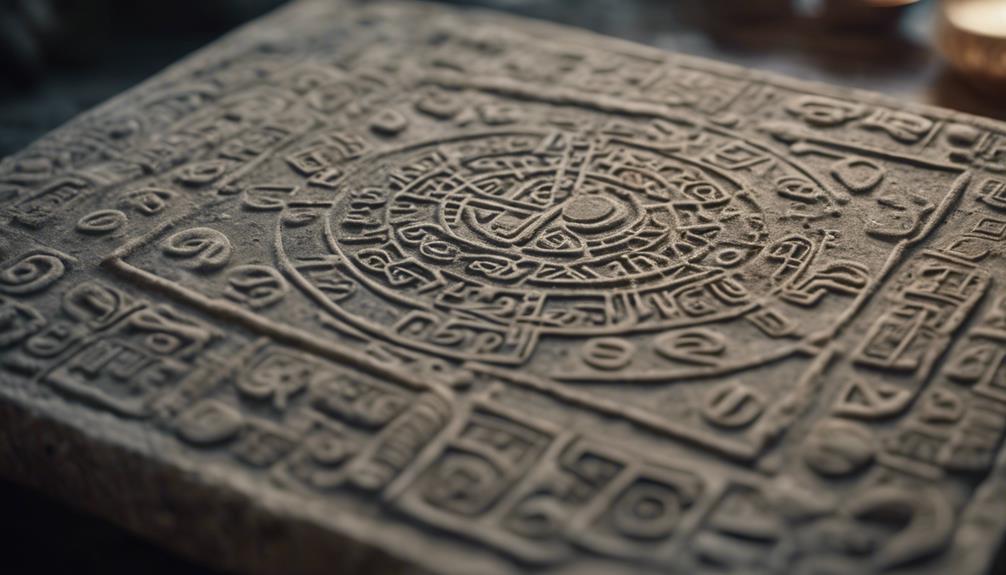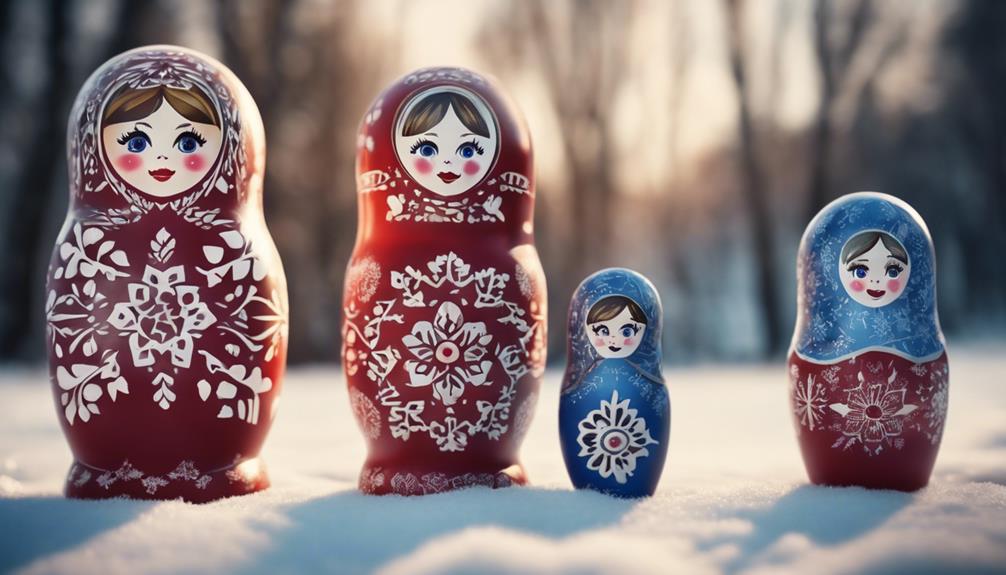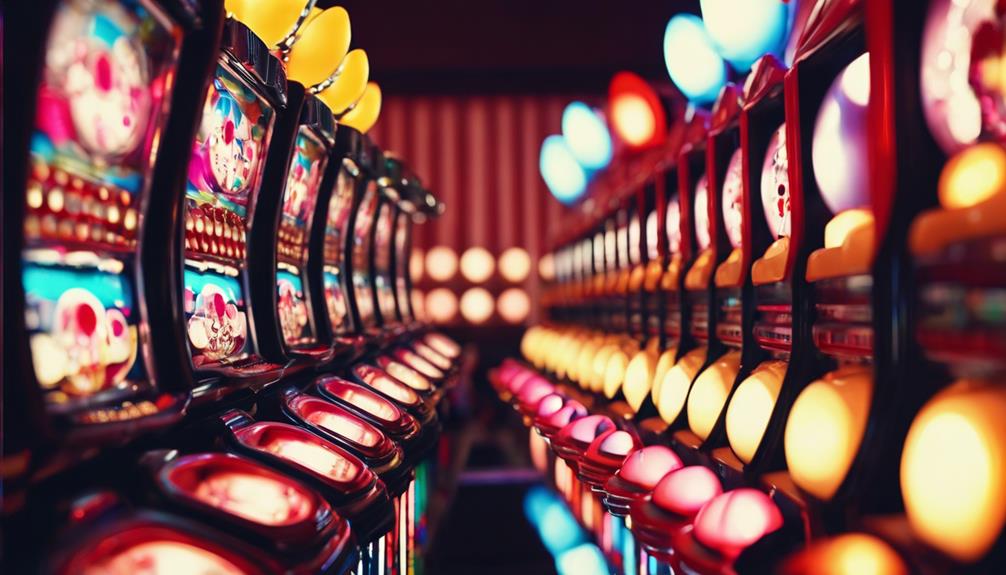Cracking the code of runic symbols **unlocks a world** full of ancient **wisdom** and Norse magic. These symbols, dating back to the 1st or 2nd century AD, came from the Germanic tribes and played a **huge role** in Viking times. Imagine each symbol loaded with its own unique power, just like in Norse myths. The runic alphabet, especially the **Elder Futhark**, features runes that stand for things like **wealth**, **strength**, and **communication**. To dig into these symbols is to step into a world of **divination and magic**. It’s like diving into a treasure chest of personal **growth**, heritage, and **spiritual** journeys. Dive in and uncover more secrets waiting in the shadows of these runic symbols!
Key Takeaways
- The runic alphabet originated in the 1st or 2nd century AD among the Germanic people.
- Elder Futhark runes symbolize Norse mythology and Viking heritage.
- Understanding individual runes like Fehu and Hagalaz is essential for empowerment and connection.
- Runes are organized into sets known as aettir, each reflecting different aspects of life or energy.
- Deciphering runic symbols is crucial for divination, magic, and personal growth.
Origins of Runic Symbols
In the 1st or 2nd century AD, among the Germanic people, the origins of runic symbols can be traced. These ancient Norse people developed the runic alphabet, with one of its earliest forms known as Elder Futhark.
During the Viking era, runes played a significant role as a writing system. The Norse belief in tapping into the forces of nature heavily influenced the creation and usage of these symbols. As Vikings engaged in extensive trading activities, the need for effective communication surged, leading to the widespread adoption of runes for writing and reading purposes.
The versatile nature of runes allowed Vikings to not only communicate but also memorialize events, conduct business transactions, seek protection, attract luck, and explore divination practices. The roots of runic symbols intertwine with the practicalities and mysticism of the Norse culture, making them a fascinating window into the past for modern enthusiasts of ancient communication methods.
Symbolism in Runic Alphabet

Exploring the symbolism embedded within the runic alphabet reveals a rich tapestry of meanings and associations tied to each of the 24 distinct symbols. These Elder Futhark runes, originating from Norse mythology and Viking heritage, hold a transformative power that resonates through the ages. For example, Fehu represents cattle, symbolizing wealth, abundance, and prosperity. Hagalaz, on the other hand, embodies chaos, destruction, and the forces of nature. The intricate meanings of these runic symbols go beyond mere letters, delving into a domain of ancient wisdom and mysticism.
In modern times, individuals often incorporate runic symbols into jewelry, tapping into their deep-rooted meanings for personal empowerment and connection to heritage. Understanding the rune meanings allows for deeper insights into their applications in divination, magic, and protection rituals. By immersing ourselves in the symbolism of each runic symbol, we open a gateway to the past and a wellspring of inspiration for the present.
Interpretation of Key Runes
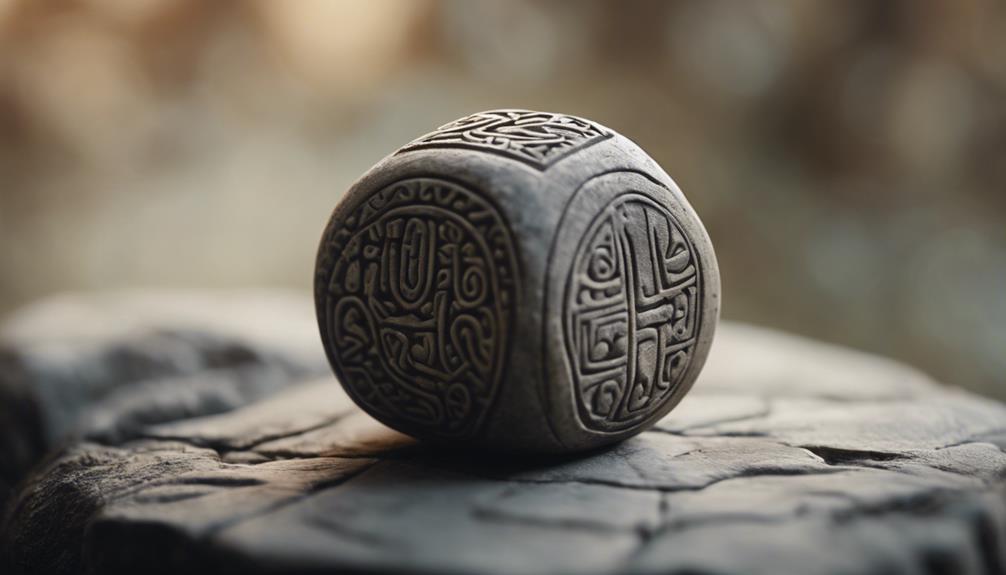
Deciphering the meanings of key runes offers a deeper insight into the intricate symbolism embedded within the runic alphabet. The Fehu rune represents wealth and prosperity, symbolizing abundance and financial success. Uruz symbolizes strength and endurance, embodying vitality and inner power.
Thurisaz rune signifies energy, force, and conflict, emphasizing the need for defense and protection. Ansuz rune relates to communication and wisdom, highlighting the power of words and knowledge.
Lastly, the Raidho rune symbolizes journey, progress, and travel, signifying movement and personal growth. Understanding these key runes provides a glimpse into the diverse aspects of life they represent – from material wealth to inner strength and the importance of effective communication.
Each rune carries a unique message, inviting us to explore further into the rich tapestry of runic symbolism and apply these insights to our daily experiences.
Deep Dive Into Rune Meanings
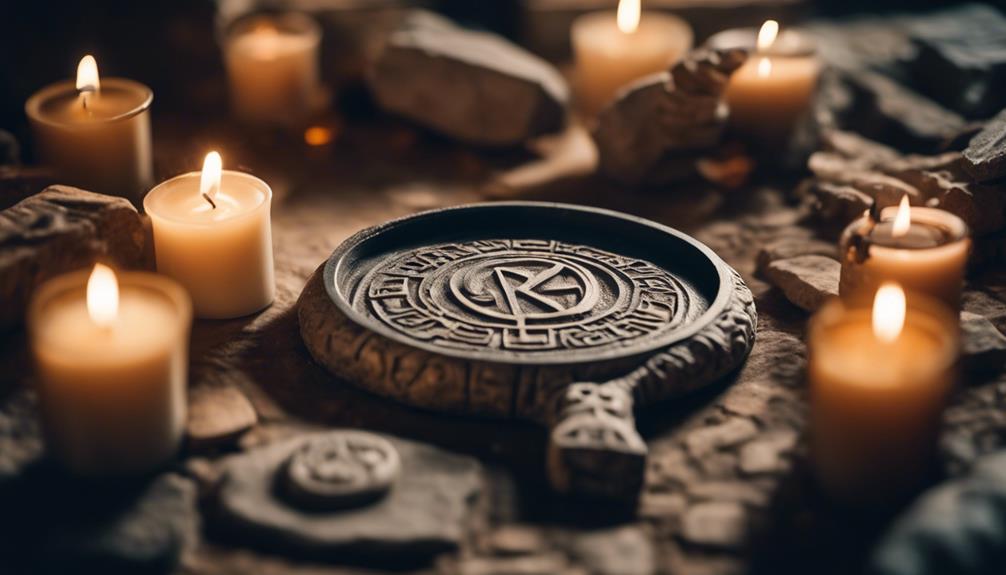
Let's explore the intricate world of rune meanings to uncover the historical significance and symbolism behind these ancient symbols. Understanding the rich tapestry of each rune's representation provides insight into the cultural contexts and values they hold.
Rune Symbolism Explained
Delving into the intricate world of runic symbols reveals a profound understanding of their symbolic meanings. When exploring the Elder Futhark runic symbols, we uncover a wealth of insights into the symbolic significance encoded within each rune. Here are four key points to contemplate:
- Each rune carries a specific meaning, such as Fehu representing abundance and Uruz symbolizing strength.
- The runes are organized into sets known as aettir, each set reflecting different aspects of life or energy.
- Understanding these runic symbols is essential for their application in divination, magic, and personal growth.
- By deciphering the meanings of individual runes, one can gain a deeper appreciation of the rich tapestry of symbolism woven into these ancient symbols.
Historical Significance of Runes
Exploring the historical significance of runes, one uncovers a wealth of knowledge about the deep meanings encoded within these ancient symbols. The Elder Futhark runic alphabet, with its 24 symbols divided into three aetts, holds immense symbolic significance. These symbols like Fehu for wealth, Thurisaz for energy and conflict, Hagalaz for change, and Isa for ice, communicate profound messages of communication, wisdom, and mystical insights. Rune stones inscribed with these powerful symbols have been used for centuries to seek guidance, protection, and understanding. Each rune in the runic alphabet reflects historical significance, offering insights into the cyclic nature of life, the power of defense, the importance of awakening, and the inevitability of change. The runes are a treasure trove of ancient wisdom waiting to be deciphered.
| Aspect | Symbolic Significance | Historical Significance |
|---|---|---|
| Fehu | Wealth and Prosperity | Reflects societal values and economic status |
| Thurisaz | Energy, Force, Conflict | Illustrates struggles and battles in history |
| Hagalaz | Change, Defense | Represents transformations and protection |
| Isa | Ice, Psychological Blocks | Symbolizes challenges and obstacles overcome |
| Jera | Harvest, Abundance, Endings, Cyclic Nature | Signifies agricultural cycles and life phases |
Practical Applications of Runes

Let's explore how runes can be applied practically in our daily lives.
From different methods of casting runes to various divination techniques, these ancient symbols offer unique ways to gain insight and guidance.
Understanding the symbolic interpretations of runes can enhance our spiritual practices and personal growth.
Rune Casting Methods
Rune casting methods, whether utilizing stones, cards, or sticks, serve as practical tools for divination and guidance in various life aspects. When it comes to Elder Futhark runic practices, interpreting meanings through different layouts can offer valuable insights.
- Runes can be cast in various layouts like the Three-Rune Spread or the Runic Cross, each providing unique perspectives.
- Different methods involve selecting runes from a bag or arranging them in specific patterns for interpretation.
- The Nine Worlds layout offers a thorough view, allowing for deep exploration of the question at hand.
- Seeking guidance from ancestral spirits or divine sources can enhance the accuracy and depth of the reading.
Divination Techniques
Utilizing runic symbols in divination offers thorough applications for gaining insights into various aspects of life through the interpretation of unique meanings and energies associated with each rune. Divination with runes involves casting or drawing these symbols to uncover information about past, present, or future events.
Practitioners use various casting methods like single rune draws, three-rune spreads, or more intricate layouts such as the Celtic Cross to provide guidance, decision-making support, problem-solving assistance, and spiritual growth opportunities. Each rune carries its own significance, and by understanding their meanings and energies, practitioners can offer detailed readings by combining intuitive interpretation with traditional rune interpretations.
This fusion allows for a deeper and more nuanced understanding of the messages conveyed through runic symbols.
Symbolic Interpretations
After exploring divination techniques with runic symbols, we can now investigate the practical applications of these symbols through symbolic interpretations.
- Fehu: This rune embodies wealth and prosperity, ideal for attracting abundance and success in various endeavors.
- Uruz: Representing strength and endurance, Uruz offers inner power and vitality, empowering individuals to overcome challenges.
- Thurisaz: Signifying energy and conflict transformation, Thurisaz aids in turning obstacles into opportunities for growth.
- Ansuz: Linked to communication and wisdom, Ansuz enhances clarity and understanding in interactions, facilitating effective communication strategies.
Modern Relevance of Runic Symbols
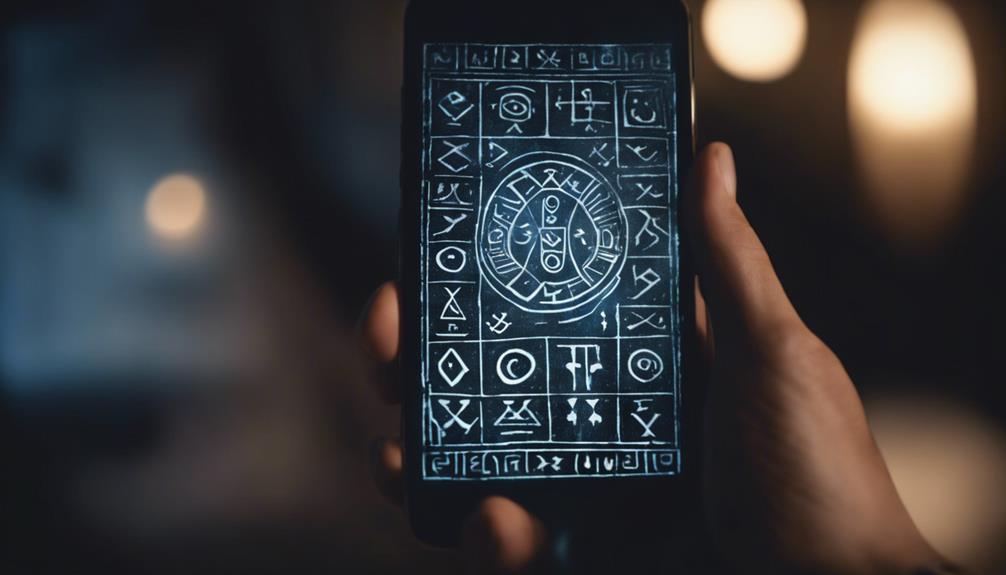
In today's society, the resurgence of interest in ancient Norse traditions has sparked a notable revival of runic symbols, evident in various forms of contemporary art and personal expression. Contemporary artists and designers are creatively incorporating these ancient Norse symbols into their work, highlighting the enduring legacy and appeal of runic symbols in modern times. Runic symbols aren't only aesthetic but also hold significance in practices such as divination, meditation, and intention setting, bridging the gap between ancient wisdom and present-day spirituality.
The mystical allure of runic symbols continues to captivate modern audiences, offering a unique blend of historical significance and personal expression. As interest in Viking and Norse culture grows, so does the appreciation for the power of these symbols for empowerment and self-expression. Whether adorning jewelry, clothing, or in the form of tattoos, runic symbols play a significant role in contemporary life, serving as reminders of ancient wisdom and symbols of personal empowerment.
Frequently Asked Questions
What Is the Meaning of the Rune Symbol?
The meaning of the rune symbol reflects its unique combination of shape, name, and associated energy. Each symbol holds specific significance for guidance, insight, and magic.
Interpretation involves exploring historical context and cultural significance. Meanings can vary based on personal experiences and beliefs. Runes connect us to inner wisdom, hidden knowledge, and future insights through divination.
What Do the 24 Runes Mean?
We interpret the 24 runes as a complex system of ancient symbols imbued with diverse meanings. Each rune encapsulates unique characteristics, from prosperity and strength to communication and progress.
These symbols serve as powerful tools for insight and guidance, providing a rich tapestry of wisdom to those who seek to understand their significance. By exploring the depths of runic symbolism, we uncover a wellspring of knowledge that illuminates the human experience.
What Is the Most Powerful Rune Symbol?
Othala, a rune symbolizing ancestral property and heritage, stands out as one of the most potent in runic divination. Its essence radiates stability, security, and a profound connection to one's roots.
Like a beacon guiding us home, Othala embodies the strength and continuity found in our family legacy. Its power lies in grounding us, offering protection, and fostering a deep sense of belonging to something greater than ourselves.
What Does It Mean to Read the Runes?
Reading the runes involves interpreting ancient symbols for guidance and insight. Each runic symbol carries a unique message, tapping into universal forces for understanding. By connecting with intuition, we decipher personalized insights akin to reading tarot cards.
This process explores subconscious depths, offering foresight and wisdom from the symbols' energies. Reading runes provides a pathway to ancient knowledge, helping us navigate life's complexities with clarity and guidance.
How Can I Decode Runic Symbols and Understand Their Meanings Similar to Decoding Animal Symbolism?
To decode runic symbols and understand their meanings similar to decoding animal symbolism, one must study the ancient runic alphabet and its associated meanings. Just as with animal symbolism, understanding the context and cultural significance of runic symbols is crucial in deciphering their hidden animal symbolism meanings understanding.
Conclusion
To sum up, while the origins of runic symbols may be ancient, their meanings continue to hold relevance in today's world. By decoding these symbols and understanding their symbolism, we can gain insight into our past and present selves.
The practical applications of runes offer a unique way to tap into the power of these symbols for guidance and self-reflection. Embracing the modern relevance of runic symbols allows us to connect with our inner wisdom and intuition in a meaningful way.

